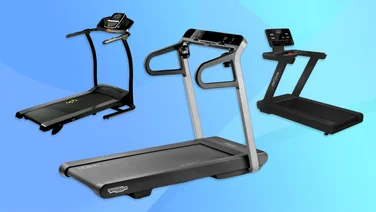To help us provide you with free impartial advice, we may earn a commission if you buy through links on our site. Learn more
- Wahoo Kickr smart turbo trainer (2018) K.O.M. bundle review: What you need to know
- Wahoo Kickr smart turbo trainer (2018) K.O.M. bundle review: Price and competition
- Wahoo Kickr smart turbo trainer (2018) K.O.M. bundle review: Design
- Wahoo Kickr smart turbo trainer (2018) K.O.M. bundle review: Features
- Wahoo Kickr smart turbo trainer (2018) K.O.M. bundle review: Performance
- Wahoo Kickr (2018) smart turbo trainer (K.O.M. Bundle) review: Verdict








- Quiet
- Excellent, realistic feel
- Superb third-party app support
- Expensive
- Kickr Core almost as good
Wahoo has a solid reputation for making smart trainers and its previous Kickr Smart Trainer was a favourite among those seeking a more interactive training experience with third-party apps such as Zwift and TrainerRoad. In fact, so comprehensive is its app compatibility that if a service doesn’t work with the Kickr Smart, it probably isn’t worth using.
With the new Kickr (2018), Wahoo has tweaked only a few details from the outgoing model. These include a quieter belt drive system, a marginally heavier flywheel and a new rubberised handle. The latter not only enables a more secure grip with sweaty hands but its position also means the trainer is much better balanced when you lift it. That might sound trivial, but it makes it much easier to shift the Kickr around without taking chunks out of your shins.
Wahoo Kickr smart turbo trainer (2018) K.O.M. bundle review: What you need to know
Indeed, the most significant changes relate to new bolt-on products that come as part of Wahoo’s King of the Mountain (K.O.M) bundle. These include a Bluetooth-controlled fan unit called the Kickr Headwind and the Kickr Climb, an incline simulator that takes virtual-reality training to the next level.








How you use the Kickr is up to you, though, and it doesn’t need to be paired with these accessories or third-party apps to be an outstanding indoor trainer. As a standalone direct drive unit – which means the bike connects directly to the trainer’s built-in cassette, as opposed to the rear tyre driving on a roller – the Kickr has a superbly realistic and stable ride feel, delivering accurate power data.
Where the Kickr shines, however, is when it comes to virtual training, with the new Kickr Climb and Headwind accessories helping to deliver a highly realistic indoor riding simulation.
Wahoo Kickr smart turbo trainer (2018) K.O.M. bundle review: Price and competition
The Wahoo Kickr Smart Trainer costs one penny shy of £1,000 on its own. To get your hands on the K.O.M. bundle, which includes the aforementioned accessories plus a Wahoo Kickr floor mat (£70), you’ll need to part with £1,770. To break down that price further, the Wahoo Kickr Headwind costs £200, while the Kickr Climb will set you back £500 on its own. There’s no saving by buying all products together, though, so you can upgrade piecemeal if you prefer.
As far as turbo trainers go, the Kickr is certainly at the top end of the cost spectrum. At £1,200, only the Tacx Neo 2 Smart Trainer and Elite Drivo II Smart Trainer have higher starting prices, but it’s difficult to see what extra benefits they provide.
If you can’t justify spending a thousand pounds on a turbo trainer, there are cheaper direct-drive options available such as the Tacx Flux S (£550) and Wahoo Kickr Core (£700). If you’re wondering how the latter differs from Wahoo’s flagship model, it offers all of the same third-party app compatibility but has a lighter flywheel and less resistance, to name the main two differences. For even more options, you can read our best turbo trainer roundup, which is updated regularly.
Wahoo Kickr smart turbo trainer (2018) K.O.M. bundle review: Design
Released at the end of summer 2018, the latest Kickr looks a lot like its predecessor. As with the previous model, it’s compatible with the majority of frame and rear-axle standards, across road, MTB, cyclocross and gravel bike platforms. To this end, there are a number of different adapters included in the box, and the base is also easily adjusted to accommodate different wheel sizes, with no tools required.
I’ve tested the Kickr with a variety of different bikes and it never took more than a few minutes to switch settings and get everything up and running. It’s a small thing, but the Kickr also comes with an extra-long power lead, which means you don’t need to park it right next to a wall socket.








As for the Kickr Headwind that comes with the K.O.M bundle, it’s a neat-looking fan unit, but you’d be justified in wondering why it costs £200 until you’ve tried it. It does add a great deal to the overall realism of the training experience by automatically altering the fan strength according to either heart rate or speed. In other words, if you ride faster, it’ll blow faster (up to 30mph), mimicking the wind resistance you’d feel outside and crucially helping to keep you cool.
The same goes for the Kickr Climb. It’s sleek and unobtrusive, and very simple to connect to the bike, essentially taking the place of the front wheel (again, adapters for different axle standards are included). Like the Headwind fan, it’s not cheap at £500 but it also plays a significant role in delivering the most realistic indoor riding simulation possible.
The Climb’s incline can be adjusted manually to simulate gradients – ascents up to 20% and descents up to 10% – when the Kickr is used in ERG mode, but when paired with a third-party app such as Zwift, it automatically mimics all aspects of the road for descents as well as climbs.








Unless you’re leaving it set up in the centre of your living room, aesthetic appeal is hardly a high priority for an indoor trainer, but I think the Kickr is undoubtedly one of the smartest looking packages and it folds away neatly for ease of storage, too.
Wahoo Kickr smart turbo trainer (2018) K.O.M. bundle review: Features
The updated Kickr design includes an improved drive belt, which Wahoo claims helps to make the new Kickr 14% quieter than its predecessor. There’s a slightly heavier 725g flywheel, too, which supposedly helps to improve the realism of the ride feel.
It has all the connectivity you would expect of a top end trainer, including Bluetooth Smart, ANT+ and ANT+FEC, which means it’s possible to use the Kickr with practically any tablet, smartphone or laptop. Some laptops may require an additional USB ANT+ dongle for full compatibility, however.








Generously, Wahoo supplies the Kickr with a Shimano 105 11-speed cassette, which means it’s ready to ride straight out of the box (assuming you’re running 11 speed Shimano or Sram on your bike). It’s compatible with most other options in the nine to 11 speed range, too, but it’s worth noting that a Campagnolo cassette would not fit the freehub and so would require a compatible cassette from a third-party brand. Also bear in mind that there’s no 12-speed Sram compatibility at this stage, although I’m confident Wahoo will have a solution for this soon.
Strangely, the Kickr does not yet have its own built-in cadence sensor but Wahoo does at least include a WahooRpm2 pod in the box, which must be attached to the crank arm of your bike to measure cadence. That’s only a two-minute job, but can feel like a fair bit of hassle if you need to frequently transfer it between bikes. You can buy additional cadence sensors to save time, though.








As mentioned earlier, the trainer can be used as a standalone unit without third-party services and without the Climb and Headwind add-ons. In this state, it’s easily controlled via the Wahoo smartphone app or used with a bar-mounted computer such as a Garmin or a Wahoo Element.
Wahoo claims the Kickr delivers up to 2,200W of resistance. I can’t validate that – there are few people who can produce that kind of power – but there’s no reason not to take Wahoo at its word.
Wahoo Kickr smart turbo trainer (2018) K.O.M. bundle review: Performance
Arguably, the most important aspect of an indoor trainer is ride feel. In this regard, the Kickr’s performance is exemplary. The ride feel is smooth and wonderfully progressive as you increase your effort level. It truly does feel akin to the sensation of riding outdoors.
Also important is that the trainer feels secure and sturdy to give you the confidence to do maximal sprint efforts and the like. Again, the Kickr delivers. It’s solid and dependable and not at all flimsy or flexy. It stood firm against my best efforts on the bike and, importantly, it stayed put during sprints, making no nasty creaks or other irritating noises.
On the topic of noise, the old model was already pretty quiet and with Wahoo claiming the new Kickr is 14% quieter still, it’s certainly one of the quietest smart turbo trainers on the market. It’s quiet enough, even during eyeballs-out sprint efforts, that there should be no worries using the Kickr Smart in a flat or workplace, where noise might disrupt others. Chances are you’ll be making more of a din with your heavy breathing.








Wahoo claims the Kickr is accurate to +/- 2% in terms of its power accuracy. This seemed to check out when compared to other power meters I used simultaneously, such as Quarq D-Zero cranks and a Stages crank. Comparing the power readings showed almost perfect symmetry. If we had to call it, perhaps the Kickr had the slightest (and we are talking fractional) tendency to over-read. It’s always worth performing a calibration each and every time (it only takes 30 seconds) to ensure the most accurate readings.
The Kickr Climb module, just like the Kickr trainer, felt stable and solid in use. It dramatically increases the realism when following set courses in virtual training apps such as Zwift. This adds an element of fun to a session but also provides more varied training, ensuring your muscles are targeted in the same way they would be out on the road. If you’ve written it off as a gaming gimmick, think again.








The Headwind, too, is a great addition. It’s more than just a pedestal fan and provides an impressive sense of having the wind in your face, not to mention adding cooling relative to your effort level. My only small gripe with the Kickr Headwind is the power lead is not overly long, so in many scenarios you’ll need to use an extension lead to position it suitably.
Pairing the Kickr trainer and its accessories was equally easy whether using Bluetooth or ANT+ and there are LED lights to show what’s connected. Importantly, connection dropouts are very rare, although I found if using multiple sensors on third-party apps, it’s best to spread the load and use both connection types at the same time. For instance, when the Kickr is connected to Zwift via Bluetooth Smart, it seemed more reliable to connect a heart rate belt and the cadence sensor via ANT+.
Wahoo Kickr (2018) smart turbo trainer (K.O.M. Bundle) review: Verdict
With the full K.O.M. bundle, you’ll be hard pushed to find a more realistic indoor experience than that offered by the Kickr. It is, quite simply, superb. And even if you buy it on its own, it’s one of the best smart trainers on the market, offering a realistic indoor cycling experience and excellent third-party app support.
Granted, it’s one of the most expensive on the market but it backs that up with a polished performance that justifies its price tag.





